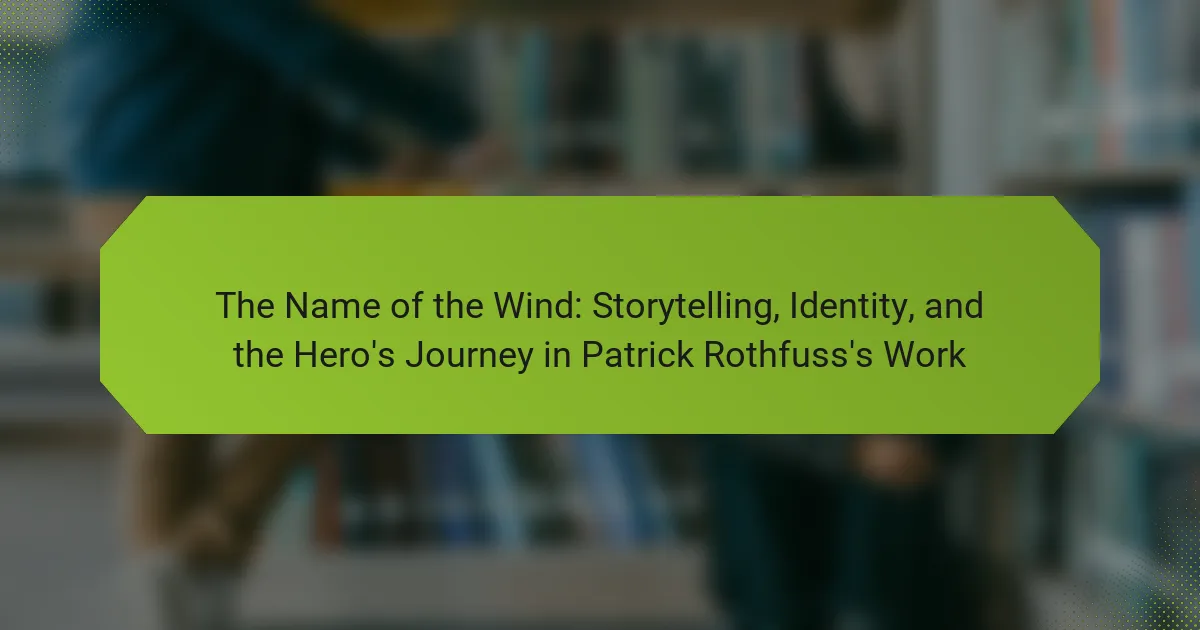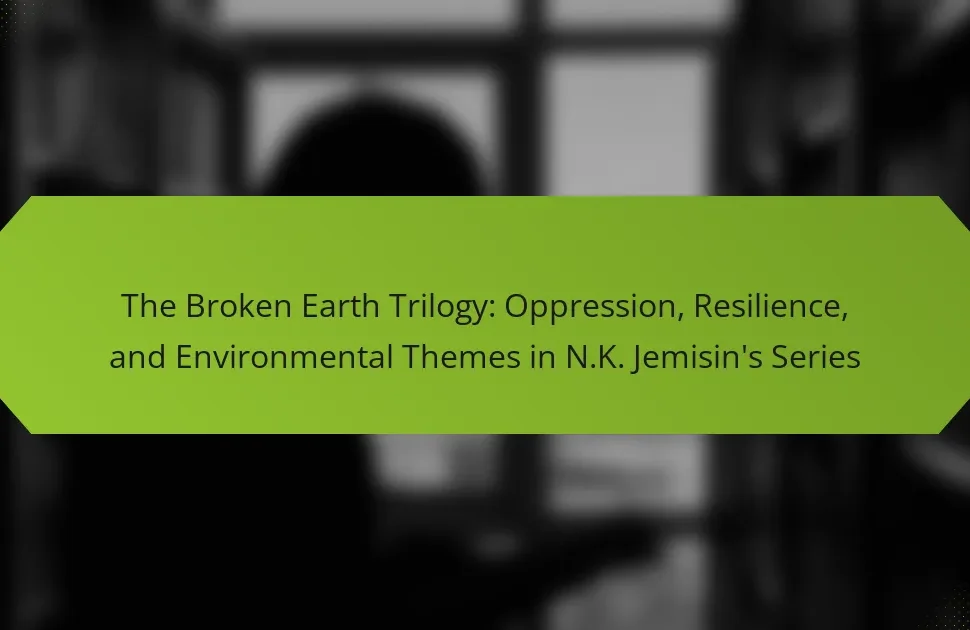Storytelling is a powerful force that shapes identity and influences personal journeys. In “The Name of the Wind,” Patrick Rothfuss explores how narratives define characters like Kvothe, blending reality with myth. The article examines the key elements of the hero’s journey, the significance of music in identity formation, and the universal themes that resonate with diverse audiences. Through Kvothe’s experiences, the complexities of heroism and the transformative power of storytelling are highlighted.

How does storytelling shape identity in ‘The Name of the Wind’?
Storytelling profoundly shapes identity in “The Name of the Wind” by illustrating how narratives define characters and their journeys. Kvothe’s life story is an intricate tapestry of experiences, legends, and personal truths. Through storytelling, he constructs his identity, blending reality with myth. This interplay emphasizes the transformative power of narratives in shaping self-perception and societal roles. Characters like Kvothe illustrate that identity is fluid, deeply influenced by the stories we tell ourselves and others. The hero’s journey in Rothfuss’s work highlights this connection, as each tale contributes to the protagonist’s evolving identity.
What narrative techniques does Rothfuss use to develop characters?
Rothfuss uses narrative techniques such as deep character introspection, nonlinear storytelling, and rich world-building to develop characters. These methods create complex identities and enhance the hero’s journey. For example, Kvothe’s perspective reveals his vulnerabilities, shaping reader empathy. The use of storytelling within storytelling further enriches character depth, allowing exploration of themes like identity and legacy. Rothfuss’s unique attribute is his ability to blend lyrical prose with intricate plot structures, making characters memorable and relatable.
How do cultural influences impact the storytelling in the novel?
Cultural influences significantly shape storytelling in “The Name of the Wind.” Rothfuss integrates diverse cultural elements, enriching character identities and narrative depth.
The novel draws on various mythologies and folklore, reflecting a blend of traditions. This interplay enhances the hero’s journey, illustrating how identity is influenced by cultural heritage. For instance, Kvothe’s experiences resonate with universal themes found in many cultures, such as the quest for knowledge and belonging.
Moreover, language plays a crucial role in storytelling. The use of lyrical prose and unique dialects adds authenticity, reflecting the cultural backgrounds of characters. This linguistic diversity deepens the reader’s connection to the narrative.
Ultimately, cultural influences in Rothfuss’s work create a rich tapestry of storytelling, where identity and the hero’s journey are intricately linked to the broader cultural context.

What are the key elements of the Hero’s Journey in Rothfuss’s work?
The key elements of the Hero’s Journey in Rothfuss’s work include the call to adventure, mentorship, trials, and transformation. These elements shape the protagonist’s identity and narrative arc.
1. Call to Adventure: Kvothe’s journey begins with a desire for knowledge and understanding.
2. Mentorship: Characters like Elxa Dal provide guidance and wisdom, shaping Kvothe’s skills.
3. Trials: Kvothe faces numerous challenges, testing his resilience and adaptability.
4. Transformation: Through experiences, Kvothe evolves, reflecting the complexities of identity and storytelling.
Which stages of the Hero’s Journey are most prominent in Kvothe’s story?
Kvothe’s story prominently features the stages of “Call to Adventure,” “Meeting the Mentor,” and “Ordeal.” These stages shape his identity and narrative arc. The “Call to Adventure” initiates Kvothe’s journey, driven by personal loss and a quest for knowledge. The “Meeting the Mentor” stage introduces characters like Elodin, who guide his development. Finally, the “Ordeal” showcases his struggles against formidable challenges, emphasizing resilience and growth. Each stage intricately weaves storytelling with themes of identity and self-discovery in Rothfuss’s work.
How does Kvothe’s journey reflect universal themes of growth and transformation?
Kvothe’s journey embodies universal themes of growth and transformation through his trials and self-discovery. His experiences reflect the hero’s journey archetype, showcasing resilience and the quest for identity. As he navigates challenges, Kvothe evolves from a naive youth to a multifaceted individual, illustrating the importance of learning from adversity. This transformation resonates with readers, emphasizing that personal growth often stems from overcoming obstacles. Rothfuss masterfully intertwines storytelling with character development, making Kvothe’s evolution a powerful narrative of human experience.

Why is music significant in ‘The Name of the Wind’?
Music is significant in “The Name of the Wind” as it embodies storytelling, emotional expression, and identity formation. It serves as a vehicle for cultural heritage and personal connection, influencing the protagonist’s journey. The unique attribute of music in this narrative is its transformative power, shaping relationships and experiences. Additionally, the root attribute of music as a universal language highlights its role in connecting characters and conveying deeper themes. Through its rhythmic and lyrical elements, music enhances the storytelling, enriching the reader’s understanding of the hero’s journey.
How does music contribute to character development and plot progression?
Music significantly enhances character development and plot progression in “The Name of the Wind” by deepening emotional resonance. It reflects characters’ inner struggles and growth, influencing the narrative arc. For instance, Kvothe’s performances reveal his identity and past, shaping audience perception. Thematic motifs in music underscore pivotal moments, reinforcing the hero’s journey. Rothfuss uses music as a narrative device, intertwining it with storytelling to create a rich, immersive experience. This unique attribute of music establishes connections between characters and events, driving the plot forward.
What role does music play in the world-building of the story?
Music plays a crucial role in world-building within “The Name of the Wind” by enhancing emotional depth and cultural context. It reflects the identity of characters and the lore of the world, enriching the narrative. For example, Kvothe’s musical talent not only showcases his unique attributes but also serves as a bridge between his past and present, influencing his journey. The songs and melodies evoke specific settings and emotions, creating a vivid atmosphere that immerses readers in the story. Music also symbolizes the connection between storytelling and personal identity, reinforcing themes of memory and legacy throughout the narrative.

Which philosophical themes are explored in ‘The Name of the Wind’?
‘The Name of the Wind’ explores themes of storytelling, identity, and the hero’s journey. The narrative emphasizes how stories shape personal identity and the quest for understanding. Kvothe’s journey illustrates the complexities of heroism, blending myth and reality. The interplay of truth and fiction challenges perceptions of identity and legacy.
How do concepts of truth and storytelling intertwine in the narrative?
Truth and storytelling are deeply intertwined in “The Name of the Wind,” as they shape identity and the hero’s journey. Kvothe’s narrative reveals how personal truth influences perception and self-conception. The act of storytelling becomes a means of forging identity, where Kvothe’s experiences are filtered through his own lens of truth. This interplay highlights the subjective nature of reality, emphasizing that each story told is a reflection of the storyteller’s beliefs and experiences. Ultimately, Rothfuss illustrates that truth is not merely factual but is constructed through the narratives we create and share.
What moral dilemmas does Kvothe face throughout his journey?
Kvothe faces numerous moral dilemmas throughout his journey, often centered on loyalty, sacrifice, and the pursuit of knowledge. His choices frequently test his identity and values. For instance, he grapples with the need to protect his loved ones while seeking vengeance against those who wronged him. Additionally, Kvothe struggles with the ethics of using his powers, particularly in relation to the consequences of his actions on others. These dilemmas shape his character development and highlight the complexities of his hero’s journey.

How does Rothfuss create a sense of place within the novel?
Rothfuss creates a vivid sense of place through rich descriptions and sensory details. He intricately weaves the landscapes and cultures of his world, making them feel alive. The use of music, folklore, and the protagonist’s personal experiences deepens the reader’s connection to the setting. Rothfuss’s unique ability to blend storytelling with environmental elements enhances the immersive quality of the narrative.
What are the key locations that shape Kvothe’s experiences?
Key locations that shape Kvothe’s experiences include the University, the Waystone Inn, and Tarbean. The University serves as a center for knowledge and self-discovery, influencing Kvothe’s identity. The Waystone Inn represents his past and the storytelling aspect of his journey. Tarbean, a city of hardship, impacts his resilience and survival skills. Each location plays a crucial role in his hero’s journey, shaping his character and narrative.
How does the setting influence character interactions and plot outcomes?
The setting significantly shapes character interactions and plot outcomes in “The Name of the Wind.” Rothfuss uses a richly detailed world to influence relationships and decisions.
The University, as a setting, fosters intellectual growth, impacting Kvothe’s interactions with mentors and peers. This environment encourages collaboration and rivalry, driving the plot forward.
The rural and urban landscapes of the world reflect different societal norms and challenges. Kvothe’s experiences in diverse settings highlight his adaptability and growth, influencing his journey as a hero.
Seasonal changes and natural elements serve as metaphors for characters’ emotional states. For instance, the storm symbolizes turmoil in Kvothe’s life, affecting his relationships and choices.

What are the unique attributes of Kvothe as a protagonist?
Kvothe possesses unique attributes that make him a compelling protagonist. His extraordinary intelligence, musical talent, and mastery of sympathy set him apart. Additionally, his complex identity shaped by trauma and ambition drives his character development. Kvothe’s journey reflects a blend of heroism and vulnerability, enhancing his relatability. His ability to weave stories and manipulate names showcases his unique connection to the world, embodying the themes of storytelling and identity in Patrick Rothfuss’s work.
How does Kvothe’s dual identity affect his relationships with others?
Kvothe’s dual identity complicates his relationships by creating trust issues and misunderstandings. His roles as a gifted musician and a feared figure shape how others perceive him. Friends and allies often struggle to reconcile these identities, leading to tension. For instance, his reputation as the “Hero of the Four Corners” contrasts sharply with his struggles for acceptance. This duality fosters both admiration and suspicion, impacting his connections significantly. Ultimately, Kvothe’s journey illustrates how identity shapes interpersonal dynamics, highlighting the complexities of self-perception and external expectations.
In what ways does Kvothe challenge traditional hero archetypes?
Kvothe challenges traditional hero archetypes by embodying complexity and vulnerability. Unlike typical heroes, he often struggles with self-doubt and moral ambiguity. His journey emphasizes the importance of storytelling and identity, showcasing how personal experiences shape heroism. This nuanced portrayal invites readers to reconsider what it means to be a hero in a multifaceted world.

How does ‘The Name of the Wind’ resonate with readers across different cultures?
“The Name of the Wind” resonates with readers across different cultures due to its universal themes of storytelling and identity. The protagonist, Kvothe, embarks on a hero’s journey that reflects common human experiences, such as loss, ambition, and the search for belonging. These themes are relatable regardless of cultural background.
Additionally, Rothfuss’s rich narrative style and intricate world-building invite readers to immerse themselves in the story, fostering a sense of connection. The exploration of identity through Kvothe’s character development allows individuals to see aspects of themselves in his journey, enhancing emotional engagement.
Moreover, the novel’s emphasis on the power of storytelling itself transcends cultural boundaries. It highlights how stories shape our understanding of the world and ourselves, making it a compelling read for diverse audiences. As a result, “The Name of the Wind” appeals to a broad spectrum of readers, uniting them through shared human experiences and the magic of narrative.
What themes are universally relatable to diverse audiences?
Themes universally relatable to diverse audiences include the quest for identity, the struggle against adversity, and the journey of self-discovery. These elements resonate in “The Name of the Wind” through the protagonist’s experiences. The hero’s journey reflects universal challenges, such as personal growth and the search for belonging. Storytelling serves as a powerful tool to connect with varied audiences, illustrating shared human experiences and emotions. Rothfuss’s work emphasizes the significance of narrative in shaping identity, making it relatable across cultures.
How do regional interpretations of the story differ?
Regional interpretations of “The Name of the Wind” reflect diverse cultural values and storytelling traditions. Different regions emphasize various aspects of Kvothe’s journey, such as heroism, identity, and community. For instance, some cultures may highlight the importance of personal sacrifice, while others focus on the communal impact of Kvothe’s actions. These interpretations shape readers’ understanding of the hero’s journey, illustrating how storytelling can vary across contexts. The unique attributes of each region’s narrative style influence the overall reception and meaning of the story.
What are best practices for engaging with Rothfuss’s narrative style?
To engage effectively with Rothfuss’s narrative style, focus on immersive world-building, character depth, and lyrical prose. Emphasize the protagonist’s internal journey, reflecting on themes of identity and storytelling. Analyze the use of framing devices and nonlinear timelines to enhance emotional resonance. Explore the interplay between myth and reality, enriching the reader’s experience through vivid descriptions and nuanced dialogue.




